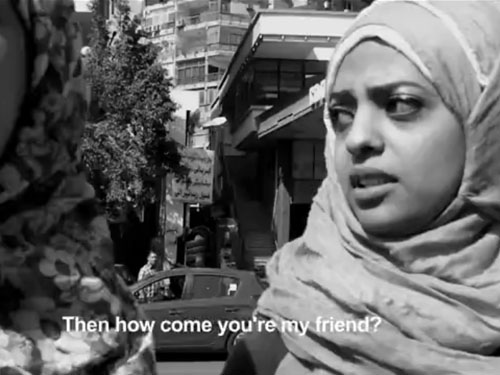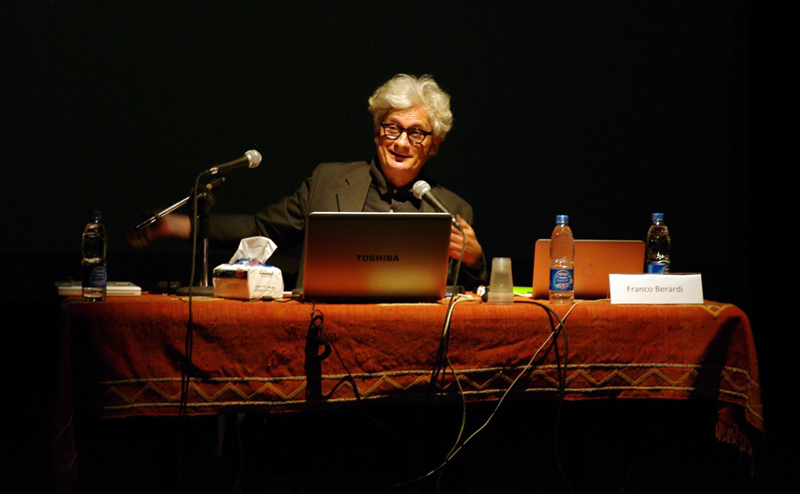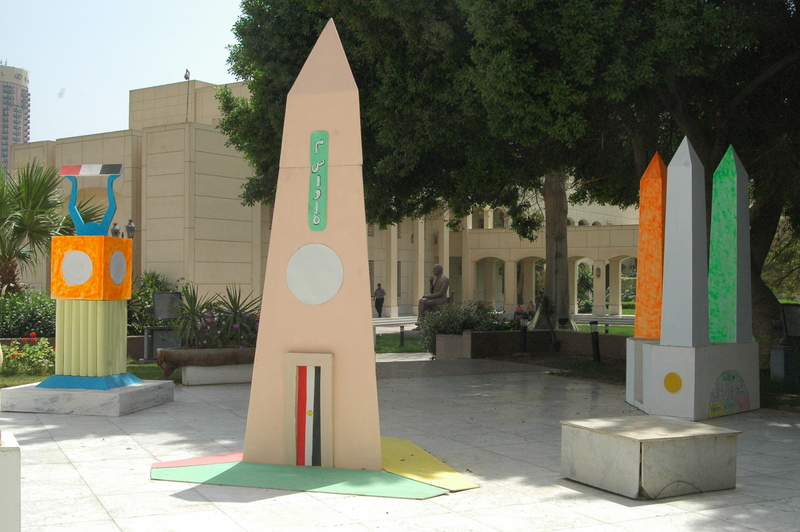The 54th Venice Biennale opens Saturday with Egyptian artist, writer and musician Hassan Khan heading the jury that will award the Golden Lion prize for the best national participation and best artist and the silver lion for a promising young artist at the ILLUMinations Exhibition.
Al-Masry Al-Youm spoke to Khan in early May about his role in the biennale in relation to his longstanding practice of institutional critique as well as the pitfalls of transnational art events.
Al-Masry Al-Youm: Following your practice as an artist, you seem to find the idea of transnational art events like biennales and the way they re-present artwork based on national identities – the model of the national pavilions – problematic. Given this background, how do you feel about your selection as the president of the jury of the world’s oldest biennale? In other words, how do you resolve this contradiction?
Hassan Khan: Yes, it’s true there is a contradiction. For the past 10 years, I’ve been attempting to problematize these power relations and structures in many different ways. Simply put, this model of representation is based upon reaffirming preconceived notions and thus ends up framing the artist and the artwork within arguments that are not theirs.
But, I’m finally starting to feel at least in my own personal career, that I’m being seen, almost, solely for my practice, rather than my background. This, however, has been the result of consistent refusals of contexts that I am not comfortable with, vocal public critiques, published responses and constant discussion of the topic.
Artists have their positions whether formal or intellectual, yet they work within a system that is not necessarily geared toward their ideas. At the same time we should never forget that they do have some power over the art system in its totality because they are the ‘fuel of that system.’ It is their responsibility to use that position, to take that risk. Things are not absolutely fixed. It’s an ongoing negotiation.
AMAY: But as a jury member, do you think you can negotiate an institution of the size of the Venice Biennale and with such an engrained structure?
HK: I tend to approach things from my own understanding of what art is. I like to think of my position as a proposition toward an argument. As a jury member in this context, I have a voice toward who gets awarded. Yet I have no say or power over anything else and it’s not within my responsibility or scope of work to address the structure of the biennale, it might in a way even be counter-productive.
In the case of the national pavilions, I would look at the artwork irrespective of the artist’s country; the discussions with the jury members would be about that.
Actually, I’m not really following who’s in the biennale. I don’t want to. I just want to go there and look at everything very carefully for the five days we have. If necessary at the time, I can also do some extra research on the practice of artists whose work I think is interesting, yet I don’t know well enough. I decided on my own beforehand not to be distracted by knowing too much about the pavilions, in a sense I wanted to avoid preconceived notions. I’ve also been on other juries before.
AMAY: You were on both the selection and awards jury of Egypt’s 20th Youth Salon in 2009 and the jury faced severe criticism at the time for its choices.
HK: It was more of a war. Artists, bureaucrats and critics bashed our selection criteria even before the salon opened to the public. We accepted only 101 artworks out of a total of 1293 submissions, as compared to the usual 300 or so. My interpretation is that the salon played a role in the general intellectual corruption of the time. It was a political tool – like many others – to bribe young people, to shortchange them from the possibility of any real participation. Most previous selections weren’t really based on criteria or a perspective, other than the reaffirmation of a vague official consensus. Young artists would make submissions and the state, represented through the Ministry of Culture, would exhibit them. That way, everyone could feel good about themselves. It’s all part of a façade whose sum total is to actually weaken the art scene. By insisting on treating the participating artists as a mass of young acolytes who need some kind of superficial encouragement, the ministry basically cancels the very validity of these artists; the possibility of having any real engagement with a professional milieu. It makes them complicit in a system in which they are supposed to be grateful for whatever is granted them, this is a system that shows no respect to its constituents, and transforms everyone into equally corrupt members of a conspiracy of mediocrity. When you make a stringent selection and put together a tight show, you shake the very basis of the whole system. This is why everybody fought the jurors.
Inviting us, (for the first time in the Salon’s history independent practitioners Bassam El Baroni, Wael Shawky and I were included) on the jury committee was a gamble on the side of the ministry. At the time the official system needed people with some credibility to symbolize some kind of thaw or “opening up.” For them the jurors were the tokens. But I don’t think they realized, we could be so strong and that once we took on the job, there was no compromise. Having a position and possessing arguments I believe also encouraged all jury members to take the issue seriously. Nobody was ready to compromise. By doing this simple thing, by insisting on doing our job, to select and try to put together a proposition, I believe we made a difference.
AMAY: You and Shawky even decided to curate the show. Much criticism was waged against the two of you for the way you decided to lay out the works, particularly the sculptures.
HK: Shawky and I intentionally overstepped our boundaries as jury members by curating the exhibition. This was absolutely legitimate, because it was our political responsibility to tackle the seat of power and attempt to present a different vision of possibility. Therefore we treated this as an opportunity and a negotiation with the art establishment. We took the initiative and in sense enacted some sort of coup. The hysterical and hyperbolic attacks we faced symbolized an insecure establishment losing power and control. The salon taught me in a concrete fashion how exhibition display can have real political repercussions, but that’s another long discussion.
It is important to note that they also, very concretely tried to compromise us, (hints at opportunities, rewards and possible punishments) to taint us within their system of corruption. It’s like a bribe. But the very basis of whatever they had to offer was of no interest to us. Especially under the Mubarak regime, which we were not ready to operate under, validate or support in any way. The only way to engage with such a regime is to trick it, and to assume power through which to propose an alternative without becoming appropriated by it. Let’s not forget that the regime’s ideologies, of course, still persist to this day. The system is still intact on all levels. However what a system of power cannot deal with is the refusal to speak its language.
AMAY: So you think, that as a jury member of the 20th Youth Salon that you’ve had some kind of lasting impact on local cultural politics? I mean you’ve seen the following edition in 2010.
HK: I felt that selectivity was lost again. However I believe the 2009 salon has had two different types of impact, an immediate one in terms of how to exhibit artworks, if even on the level of pure form. And another more diffuse less perceptible influence in terms of defining the political in relation to institutional consensus.
Ironically for some, our selection could be seen as conservative. The expectation was that we’d focus on new media, but we confounded their expectations because we are not who they think we are. The medium is not where the value of the work resides. For instance, if faced with an oil landscape painting and we sensed that there was some kind of investment, exploration, or charge within it that went beyond mere craftsmanship, we’d select it. The official establishment’s understanding of development and progress is a superficial one that remains restricted to mediums. If institutions (state or otherwise) want to talk about development in art, they should work on their own structures, rather than artwork. They should examine how their museums are structured and function – something purely institutional. But that’s never what institutions are really interested in because they’d then risk losing control. That safeguarding of power is the basis of corruption.
AMAY: You’ve made your approach to the Venice Biennale clear. And going back to Venice, how do you feel about the selection of works by the late Ahmed Basiony for the Egyptian pavilion at the Biennale?
HK: I have to say that I have mixed feelings about it. I think Basiony was an interesting artist. The really sad thing about the selection is that neither Basiony’s practice, nor those of other artists from his generation would have been represented at the Egyptian pavilion in Venice had he not been martyred on 28 January. I know that Shady el-Noshokaty who proposed the idea to the Culture Ministry is absolutely sincere in his motivations. Had it been the ministry’s idea, I would have been immediately against it because I’m sure their reasons would have been exploitative. The most dangerous thing for revolution is representation, unless it has clear goals and aims that serve the revolution practically.
AMAY: So does the fact that the Ministry accepted it also bother you?
HK: They accepted it because if they fought it, they would’ve looked really bad for refusing a ‘martyr.’ It helps make them seem valid, concurrent, and part of the new social order. So it’s all for the wrong reasons. As I said, the system has not changed, it just takes on different colors. But nobody is tricked by the cosmetic changes introduced. Whether one engages with the ministry or boycotts it all together, is an ongoing discussion. It’s something I think about all the time, especially now. The decision isn’t as clear as it used to be.
AMAY: But many artists are feeding into the whole “revolutionary artwork;” and there have already been numerous exhibitions about Basiony and the revolution.
HK: I believe we are going to see a lot of terrible work for a long time. It’s just going to happen no matter what. People are going to exploit this 100 percent in all media. Politically, it’s problematic because the revolution is not something that is done and over that we can now neatly shut in a drawer and remember nostalgically. Nothing has been resolved. By making artworks or feature films representing the revolution, especially now, you end up stealing the revolution from the revolution. The revolution of course has an impact upon everyone, but one doesn’t contribute to it by painting crowds demonstrating. It might be acceptable in popular arts because it doesn’t try to make big claims. But art is a space, which I believe should go beyond mere celebration and condemnation. And by just ‘representing’ the revolution, you’re only promoting yourself through something that everybody has a stake in. This again is the old regime with a new face.
AMAY: For years now, there’s been a specific interest in the region with increased geographical shows and the establishment of mega institutions. These structures often provide excellent production, exhibition and networking opportunities, yet they sometimes risk emphasizing the same stereotypes or misconceptions about artistic production from the Middle East. How do you see such structures?
HK: Many have been emphasizing the same ‘regional ghetto.’
AMAY: Exactly. Can you also tell us about your recent experience with the “Told/Untold/Retold” opening exhibition of the Mathaf (The Arab Museum of Modern Art) in Doha?
HK: The Mathaf case is quite different, though. Mathaf is a new institution, so it does offer a lot of potential for the art scene in the region. There was an insistence on certain production standards and I personally think it was the best put together exhibition I’ve seen in the region, at least in terms of how it was installed. In relation to the question of how it identifies itself as the Arab Museum of Modern Art, that’s in this case less problematic than if this museum was in London, for example. The fact that it’s within the region, means it plays a different role that I think is an important one so far. I’ve managed to produce a work that I hadn’t been able to for four to five years. I had tried to produce it, submitted many proposals yet was unable to raise the production for it. Of course we’ll have to see what happens, but this is part of the role such an institution can play, especially that no other similar institution currently exists in the region.
AMAY: To wrap up, I'd like to go back to the idea of 'responsibility' which you repeatedly mention in relation to how you engage with various structures differently and how it drives you to constantly re-negotiate the art system.
HK: Well to be absolutely clear I find that my first responsibility is to myself and my work. I make my choices based on what I think best serves this. When I use the word ‘myself’ it also means the sum total of my opinions, political positions and proposed arguments, so it’s not a contradiction between the individual self and a responsibility toward a collective. However it’s a constant negotiation because no situation can totally live up to your idea of what things should be. Between your ideas as a fully valid independent voice and the weight of structures and systems lies a game of chess that can be ultimately productive. There are invitations that I would refuse, and have, without a second thought. Others, I refuse after some thinking and there are still others that I might accept even if I have some reservations. It’s all based upon this responsibility to one’s self.




